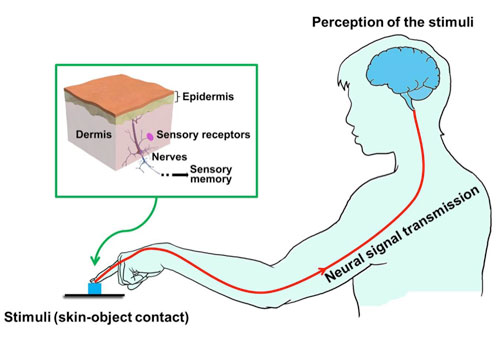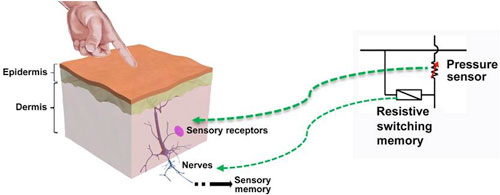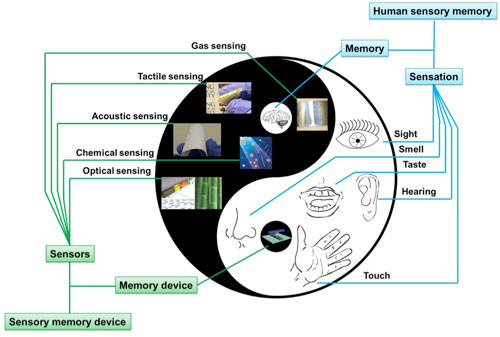| Posted: Dec 23, 2015 | |
Skin-inspired haptic memory devices |
|
| (Nanowerk Spotlight) Our sense of touch connects us to the world around us and is an integral part of how we experience things, both physically and emotionally. Human skin is a sensitive detector of both pressure and temperature, and efforts to develop similar sensors for electronics are widespread. The exquisite sensation functions of natural skin have inspired the rapid advancements of skin-like sensing devices, especially tactile sensors, for electronic skin applications. | |
| When skin gets stimulated by external impulses it sends the resulting sensory information through afferent neurons to the brain to form haptic (from the Greek word Haphe, pertaining to the sense of touch) memory. This allows us to retain the impressions of the stimuli. | |
 |
|
| Fig.1: Schematic illustration of tactile signal transmission. Skin contacts with an object and transmits the sensation information to somatosensory area of brain through afferent nerves to form sensory memory. (Image: The Xiaodong Chen Group, Nanyang Technological University) | |
| Current research on tactile sensors is mostly focused on the improvement of sensitivity and multi-functionality to emulate the function of natural skin. However, natural skin can sense external pressure and help form haptic memory, while current flexible tactile sensors for electronic skin can only perform sensing functions. | |
| This functionality gap between state-of-the-art tactile sensing devices and natural skin inspired a team of researchers in Singapore to develop haptic memory devices that integrate sensor and memory functions. | |
| In new work, the scientists describe a strategy to realize the detection and retention of tactile sensation by haptic memory devices for the mimicry of the human sensory memory. They report their findings in the December 16, 2015 online edition of Advanced Materials ("Skin-Inspired Haptic Memory Arrays with an Electrically Reconfigurable Architecture"). | |
| "Our work successfully addresses the mimicry of haptic memory by the preparation of haptic memory arrays where applied pressure could modulate the memory states of the devices," Xiaodong Chen, an associate professor in the School of Materials Science & Engineering at Nanyang Technological University, tells Nanowerk. "Our haptic memory device not only could detect external pressure via resistive pressure sensors, but also 'memorize' it in the form of resistance states." | |
| The researchers fabricated the sensitive layer of the resistive pressure sensor from microstructured PDMS film embedded with silver nanowires. Their resistive switching memory device takes advantages of typical metal-insulator-metal architecture with SiO2 serving as switching layer, providing fast switching time, high endurance as well as nonvolatile memory. | |
| The pressure information can be retained in the devices for a long time due to the nonvolatile performance memory cells used. Moreover, the external pressure distribution could be perceived by the introduction of device arrays. | |
| According to the team, the advantage of their device lies in the rational design and integration of resistive tactile sensors and resistance switching memory cells (see figure 2). | |
 |
|
| Fig.2: Skin-inspired haptic memory arrays. Each haptic memory device can be attributed to the integration of a resistive pressure sensor and a resistive switching memory device. (Image: The Xiaodong Chen Group, Nanyang Technological University) | |
| "Each haptic memory device can be attributed to the integration of a resistive tactile sensor and a resistive switching memory device, where the resistance states in a memory cell can be electrically reconfigured by applied pressure on a sensor," explains Chen. | |
| He adds that such a resistive switching memory device is an excellent candidate for the integration with pressure sensors to achieve haptic memory – it could be utilized to emulate the memory functionality of the brain by constructing artificial neuromorphic networks as it behaves similarly to synapses among neurons in storing analogue value. | |
| Information is stored and operated in resistive switching memory device because a cell can be electrically configured between a high resistance state (HRS) and a low resistance state (LRS), corresponding to an OFF (0) and an ON (1) state, respectively. | |
| Similarly, a resistive pressure sensor reflects the loading or unloading of an external force by changes in resistance. | |
| "The similarity in the resistive switching memory and resistive tactile sensing devices inspires us to build haptic memory devices to realize the nonvolatile memory of applied pressure by programming memory cells with the resistance change in tactile sensors," notes Chen. | |
| These haptic memory arrays could be applied in humanoid robotics and human-machine interfaces to preprocess the sensation information at the contact points so as to reduce the amount of information needed to be transferred to processors and free the latter for more intelligent tasks. | |
| The haptic memory arrays could also be integrated with prosthetics to provide feedback regarding external stimuli for rehabilitation applications. | |
| Although state-of-the-art sensing devices have demonstrated great capabilities in responding to physical quantities, such as chemicals, gas, sound, light and pressure, there still exists a huge gap between technical sensing systems and biological systems. | |
 |
|
| Fig.3: Schematic illustration of integrating different sensors with memory devices for the mimicry of human sensory memory. (Image: The Xiaodong Chen Group, Nanyang Technological University) (click on image to enlarge) | |
| "The human body has five sensation modalities: touch, sight, hearing, taste and smell; these senses and their memory are not isolated but often work together," says Chen. "This has inspired us to work towards integrating memory devices with multiple sensing units to build highly integrated systems for the mimicry of human sensory memory. | |
 By
Michael
Berger
– Michael is author of three books by the Royal Society of Chemistry:
Nano-Society: Pushing the Boundaries of Technology,
Nanotechnology: The Future is Tiny, and
Nanoengineering: The Skills and Tools Making Technology Invisible
Copyright ©
Nanowerk LLC
By
Michael
Berger
– Michael is author of three books by the Royal Society of Chemistry:
Nano-Society: Pushing the Boundaries of Technology,
Nanotechnology: The Future is Tiny, and
Nanoengineering: The Skills and Tools Making Technology Invisible
Copyright ©
Nanowerk LLC
|
|
|
Become a Spotlight guest author! Join our large and growing group of guest contributors. Have you just published a scientific paper or have other exciting developments to share with the nanotechnology community? Here is how to publish on nanowerk.com. |
|
